Posted by Brent Modzelewski on August 1, 2020
Essential Wine Tools
Must-Have Paraphernalia
There are a few essential wine items that you should have (and they won't break the bank).
The most obvious being a wine bottle opener (i.e. corkscrew).
Openers come in various styles and a range of prices.
Consider the Wine2Oh logo as a Stamp of Approval for key items below.
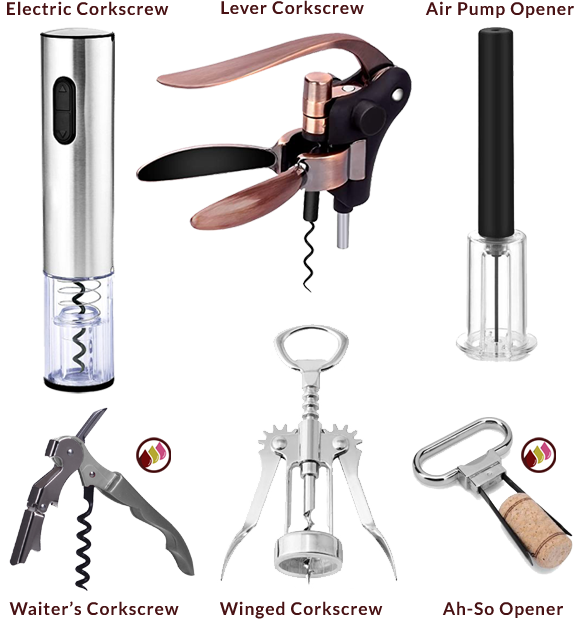
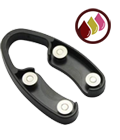 Not a big fan of the serrated knife on the Waiter's Corkscrew for cutting the foil.
It tears the foil and allows bits of the foil to fall into the glass.
I recommend pulling the entire capsule off with your hand if you can, which leaves a clean lip for pouring.
If you are unable to do that, your next best option is to use a foil cutter, especially on those Italian wines that have a DOC/DOCG paper label around the capsule.
Not a big fan of the serrated knife on the Waiter's Corkscrew for cutting the foil.
It tears the foil and allows bits of the foil to fall into the glass.
I recommend pulling the entire capsule off with your hand if you can, which leaves a clean lip for pouring.
If you are unable to do that, your next best option is to use a foil cutter, especially on those Italian wines that have a DOC/DOCG paper label around the capsule.
Need a refresher on terminology? Check out the Wine Bottle Anatomy blog post.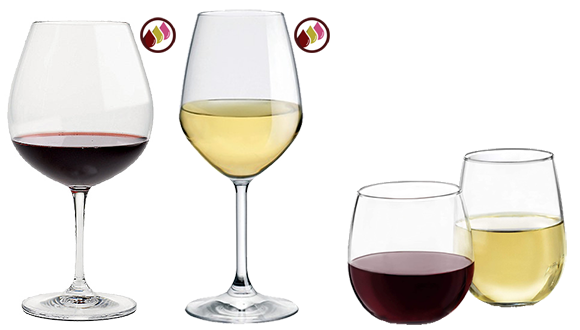 You are going to be experiencing the wine from the glass, so my suggestion is to buy the best wine glasses that are affordable to you.
You wouldn't eat a filet mignon and lobster tail on a paper plate, so why would you drink a $50 cabernet sauvignon out of a wine glass from the dollar store?
Riedel, Schott Zwiesel and Spiegelau have affordable lines of glasses (about $10/glass) as well as high-end glasses ($150+/glass).
IKEA has super cheap wine glasses less than $3/glass to get you started.
Highly recommend stemmed glasses versus non-stemmed glasses.
There is a reason why wine glasses are called stemware.
Stemmed glasses make it easier to swirl the wine and helps to maintain the wine at the proper temperature (rather than the temperature of your hand).
You are going to be experiencing the wine from the glass, so my suggestion is to buy the best wine glasses that are affordable to you.
You wouldn't eat a filet mignon and lobster tail on a paper plate, so why would you drink a $50 cabernet sauvignon out of a wine glass from the dollar store?
Riedel, Schott Zwiesel and Spiegelau have affordable lines of glasses (about $10/glass) as well as high-end glasses ($150+/glass).
IKEA has super cheap wine glasses less than $3/glass to get you started.
Highly recommend stemmed glasses versus non-stemmed glasses.
There is a reason why wine glasses are called stemware.
Stemmed glasses make it easier to swirl the wine and helps to maintain the wine at the proper temperature (rather than the temperature of your hand).
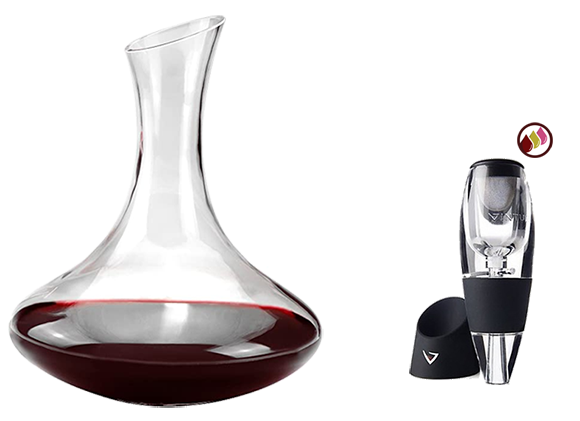 There are two main issues with decanters. First, I am too impatient to pour the wine into a decanter and wait hours to drink it.
Second, cleaning and drying the decanter after use is challenging.
For everyday drinking, I use a Vinturi Aerator. Just hold it over your glass and pour the wine through it.
It opens up the aromas and flavors similar to a couple hours of decanting.
However, I don't believe it softens tannins quite as much as an actual decanter.
For only $30, it is a worthwhile tool to have. Skip the white wine version, you don't need it.
Avoid the Vinturi knock-offs, they don't seem to work as well.
There are two main issues with decanters. First, I am too impatient to pour the wine into a decanter and wait hours to drink it.
Second, cleaning and drying the decanter after use is challenging.
For everyday drinking, I use a Vinturi Aerator. Just hold it over your glass and pour the wine through it.
It opens up the aromas and flavors similar to a couple hours of decanting.
However, I don't believe it softens tannins quite as much as an actual decanter.
For only $30, it is a worthwhile tool to have. Skip the white wine version, you don't need it.
Avoid the Vinturi knock-offs, they don't seem to work as well.
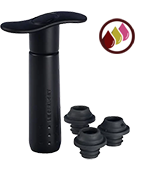 Although aeration for wine is good, too much of a good thing is bad.
An open bottle of wine won't last very long being exposed to the air in the bottle.
On those days when you aren't planning to finish the entire bottle of wine, your simplest option is to use a wine vacuum to preserve the wine.
For about $10 you can find a manual pump vacuum like this one.
Using the vacuum, red wine will hold up pretty nicely for 4 or 5 days at room temperature, whereas white wines stored in the refrigerator can last up to a week.
Although aeration for wine is good, too much of a good thing is bad.
An open bottle of wine won't last very long being exposed to the air in the bottle.
On those days when you aren't planning to finish the entire bottle of wine, your simplest option is to use a wine vacuum to preserve the wine.
For about $10 you can find a manual pump vacuum like this one.
Using the vacuum, red wine will hold up pretty nicely for 4 or 5 days at room temperature, whereas white wines stored in the refrigerator can last up to a week.
Openers and Corkscrews

Foil Cutter
 Not a big fan of the serrated knife on the Waiter's Corkscrew for cutting the foil.
It tears the foil and allows bits of the foil to fall into the glass.
I recommend pulling the entire capsule off with your hand if you can, which leaves a clean lip for pouring.
If you are unable to do that, your next best option is to use a foil cutter, especially on those Italian wines that have a DOC/DOCG paper label around the capsule.
Not a big fan of the serrated knife on the Waiter's Corkscrew for cutting the foil.
It tears the foil and allows bits of the foil to fall into the glass.
I recommend pulling the entire capsule off with your hand if you can, which leaves a clean lip for pouring.
If you are unable to do that, your next best option is to use a foil cutter, especially on those Italian wines that have a DOC/DOCG paper label around the capsule.
Need a refresher on terminology? Check out the Wine Bottle Anatomy blog post.
Wine Glasses
Once your wine is open, you need to get it into a glass. Wine glasses unto themselves are an entire discussion. Ideally you would want to have a specific wine glass for each style of wine you are drinking, but that is highly presumptuous, pretentious and expensive. Best to start with a minimum of a set of white wine glasses and a set of red wine glasses (e.g., Burgundy glass). In general terms, the main differences between a red wine glass and a white wine glass is a red wine glass has a larger bowl and a white wine glass has a narrower mouth. The larger bowl in the red wine glass allows for increased surface area for aeration and allows the complex flavors and aromas to develop. Whereas the narrower mouth of the white wine glass funnels the more subtle aromas of white wine to your nose, as well as directs higher acidity white wines to the center of your palette. You are going to be experiencing the wine from the glass, so my suggestion is to buy the best wine glasses that are affordable to you.
You wouldn't eat a filet mignon and lobster tail on a paper plate, so why would you drink a $50 cabernet sauvignon out of a wine glass from the dollar store?
Riedel, Schott Zwiesel and Spiegelau have affordable lines of glasses (about $10/glass) as well as high-end glasses ($150+/glass).
IKEA has super cheap wine glasses less than $3/glass to get you started.
Highly recommend stemmed glasses versus non-stemmed glasses.
There is a reason why wine glasses are called stemware.
Stemmed glasses make it easier to swirl the wine and helps to maintain the wine at the proper temperature (rather than the temperature of your hand).
You are going to be experiencing the wine from the glass, so my suggestion is to buy the best wine glasses that are affordable to you.
You wouldn't eat a filet mignon and lobster tail on a paper plate, so why would you drink a $50 cabernet sauvignon out of a wine glass from the dollar store?
Riedel, Schott Zwiesel and Spiegelau have affordable lines of glasses (about $10/glass) as well as high-end glasses ($150+/glass).
IKEA has super cheap wine glasses less than $3/glass to get you started.
Highly recommend stemmed glasses versus non-stemmed glasses.
There is a reason why wine glasses are called stemware.
Stemmed glasses make it easier to swirl the wine and helps to maintain the wine at the proper temperature (rather than the temperature of your hand).
Wine Decanters
Aeration of red wines is very important. Especially for younger reds. Decanting exposes the wine to air over a large surface area. More often than not, decanting improves a red wine by softening tannins and bringing out aromas and flavors. There are two main issues with decanters. First, I am too impatient to pour the wine into a decanter and wait hours to drink it.
Second, cleaning and drying the decanter after use is challenging.
For everyday drinking, I use a Vinturi Aerator. Just hold it over your glass and pour the wine through it.
It opens up the aromas and flavors similar to a couple hours of decanting.
However, I don't believe it softens tannins quite as much as an actual decanter.
For only $30, it is a worthwhile tool to have. Skip the white wine version, you don't need it.
Avoid the Vinturi knock-offs, they don't seem to work as well.
There are two main issues with decanters. First, I am too impatient to pour the wine into a decanter and wait hours to drink it.
Second, cleaning and drying the decanter after use is challenging.
For everyday drinking, I use a Vinturi Aerator. Just hold it over your glass and pour the wine through it.
It opens up the aromas and flavors similar to a couple hours of decanting.
However, I don't believe it softens tannins quite as much as an actual decanter.
For only $30, it is a worthwhile tool to have. Skip the white wine version, you don't need it.
Avoid the Vinturi knock-offs, they don't seem to work as well.
Wine Preservers
 Although aeration for wine is good, too much of a good thing is bad.
An open bottle of wine won't last very long being exposed to the air in the bottle.
On those days when you aren't planning to finish the entire bottle of wine, your simplest option is to use a wine vacuum to preserve the wine.
For about $10 you can find a manual pump vacuum like this one.
Using the vacuum, red wine will hold up pretty nicely for 4 or 5 days at room temperature, whereas white wines stored in the refrigerator can last up to a week.
Although aeration for wine is good, too much of a good thing is bad.
An open bottle of wine won't last very long being exposed to the air in the bottle.
On those days when you aren't planning to finish the entire bottle of wine, your simplest option is to use a wine vacuum to preserve the wine.
For about $10 you can find a manual pump vacuum like this one.
Using the vacuum, red wine will hold up pretty nicely for 4 or 5 days at room temperature, whereas white wines stored in the refrigerator can last up to a week.
Wine Nerd Fact Information
Have you ever watched a sommelier open a bottle of wine?
I am sure you have, but probably never paid attention to the details of what they do.
First, the sommelier, using both hands, presents the bottle to the customer, so the customer can confirm the wine/vintage is what they ordered.
Second, with the knife on their Waiter's Corkscrew, they cut away the foil.
They do this by keeping the bottle label toward the customer and run the knife around the bottle between the Collar and the Neck.
Doing so allows them to remove the foil cap from the entire Finish of the bottle.
Again, using the Waiter's Corkscrew they remove the cork, gently and quietly, without hearing the pop from the bottle.
All while having the bottle label facing the customer.
Minimizing bottle movement throughout the process keeps any sediment from being stirred up into the wine.
The cork is then removed from the corkscrew and placed in front of the customer.
And what is the customer supposed to do with the cork? Smell it? No, smelling the cork doesn't tell you much about the wine quality.
Inspecting the cork to see if it is damaged or wet through-in-through can be an indication that the wine is fouled.
Right-handed sommeliers will pour from your right, while left-handed sommeliers will pour from the left.
A small amount of wine is poured into the customer's glass for the customer to sample.
If the wine is acceptable to the customer, the sommelier will proceed to pour wine for the remaining guests at the table, before returning to the original customer to complete his or her pour.
All of this is performed without the bottle ever touching the table. They make the process look easy and effortless.
It isn't as easy as it appears to do this all without setting down the bottle.
Wine2Oh Recommended Wine
Cabernet Sauvignon
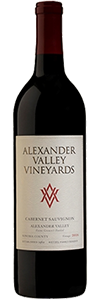
Alexander Valley Vineyards is an underrated vineyard with nondescript bottle labels. If you are ever in the Healdsburg, CA area be sure to stop in for a visit, cave tour and barrel tasting.
Alexander Valley Vineyards Cabernet Sauvignon
Flavors of cherry, black currant, blackberry and cocoa are accompanied by aromas of plum, vanilla and chocolate. Price $16.
Disclaimers: We are not affiliated, sponsored or funded for this blog post. It is purely for the love of wine.
Copyright Great Meadow Products, LLC. All rights reserved.
